Physical Therapy with the GYROTONIC® Method
Blog Content Interviews // April 26, 2017
Justine Bernard, GYROTONIC® and GYROKINESIS® Master Trainer, took time to sit down with me and share her perspective on being a physical therapist and using the Gyrotonic Method as a therapy tool for the diverse patient base coming into her studio, Elements Fitness and Wellness Center in Washington D.C.
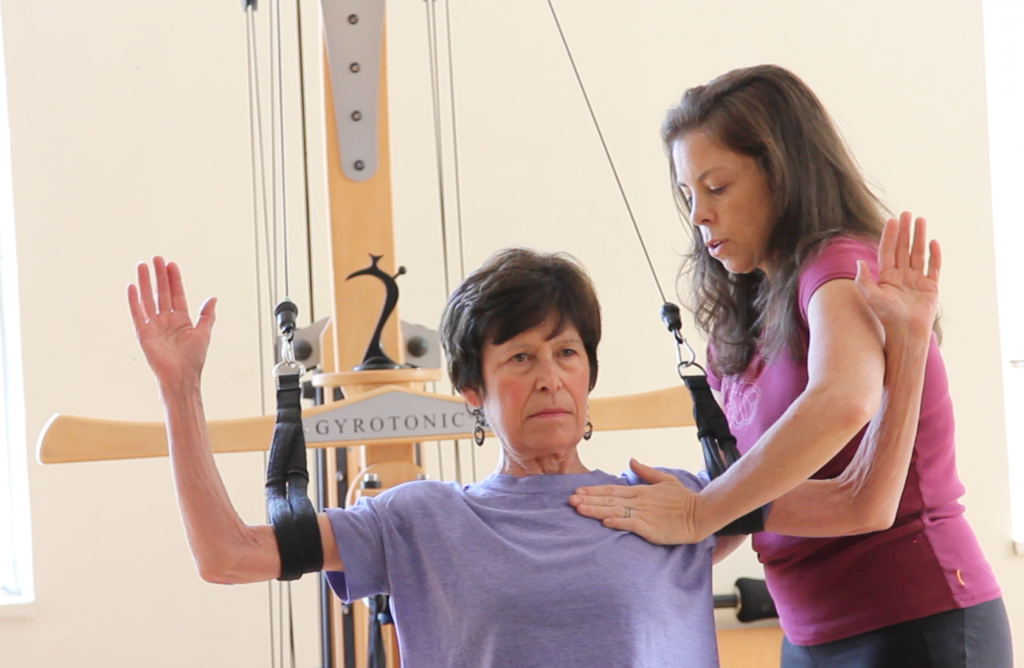
Justine working with a client on the Gyrotonic Pulley Tower
Cina: Justine, thank you so much for taking the time to meet with me. By the looks of your studio, you are very busy! Okay, so which came first, being trained as a Physical Therapist or a Gyrotonic instructor?
Justine: I was first a Gyrotonic instructor and started teaching in 1994, and then I went back and started PT school in 2000. I had the benefit of studying the method before learning the science behind it, so I could really take it in.
About 8 years ago, I opened this practice, Elements Center in Washington D.C.. We incorporate the Gyrotonic Method as our therapeutic exercise program for physical therapy. Pretty much everyone who comes to us will use this system as part of their therapeutic program.
In Washington D.C., you’re allowed to have physical therapy aides. We have six physical therapists, and four are both Gyrotonic instructors and physical therapists. We also have six Gyrotonic instructors who are physical therapy aides. The physical therapists will do the evaluations and set up treatments. The aides can then carry out the treatment using the Gyrotonic system.
We are set up to take Medicare, so people can use the machines for free with their treatments. For those not on Medicare, we are out of network for all major insurance companies. However, since many of our clients’ plans have out-of-network benefits to cover this kind of therapy, it allows us to diversify the population we serve.
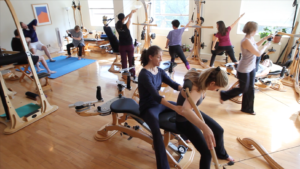
Cina: Tell me more about that broad spectrum of people and needs you address.
Justine: Well, I have a range that can go from a 12-year old patient with a hip flexor strain, to Medicare patients over the age of 65 who are climbing mountains, hiking and biking many miles. We also we have a lot of patients with chronic pain, overuse syndrome, fibromyalgia, paraplegia, and more. Really, from the elite athlete to the most injured person you can imagine, we’ve treated them here. And because we have people in wheelchairs, it was very important to me that our building be wheelchair accessible, so it is.
Cina: How do the various pieces of Gyrotonic equipment help you in treating this wide variety of need?
Justine: With the Jumping Stretching Board, you can treat people with spinal injury in complete jumping, even when they haven’t jumped in years. With the Archway, we just bump the wheelchair up into the Archway and people can hang from it and do all kinds of arm and back strengthening, even traction. We’ve had children with cerebral palsy on the Pulley Tower, stretching out their tight tendons and ligaments. It’s more than just stretching, though, because they’re mobilizing the tissue when you have them do it with movement. The fascia, the muscles, the nerves — all the systems are moving and it affects every level of the being.
Cina: As a physical therapist, it seems this system can help you in unique ways.
Justine: One of the biggest benefits of this system is the way the machines are designed because you can go through a full range of motion for any joint. In the spine, there are so many joints at each vertebra, that if one is stuck, another one can be hypermobile.
In the PT world, there is a lot of focus on stability, specifically lumbar stability. The problem with that, though, is that you haven’t looked above and below where the hypomobile, the less mobile, parts are. Yes, you can stabilize the hypermobile as much as you want, but until you mobilize the part that isn’t moving, there is just going to be a compensation pattern happening. However, the Gyrotonic equipment and the principles from the Gyrotonic system, like narrowing of the pelvis and stability through contrast, allow you to stabilize the spine and also mobilize it at the same time.
If there is a hypermobile point, you can stabilize it with the narrowing of the pelvis. You can mobilize the thoracic spine where it’s stuck, or at the other levels of the spine. Then you can add rotation, flexion, and side-bending. For each movement of the joint, you can move it the way it needs to move so that the whole spine is balanced as opposed to just one level of the spine.
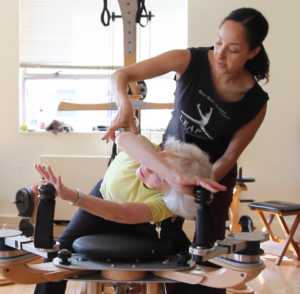
You have to address the whole spine. You can do that with the Gyrotonic Method. Because of the design of the equipment, you can move the spine three-dimensionally in any range. I can move it with rotation and extension, or side-bending with extension or flexion, or wherever the person is stuck.
If they want to play tennis, golf, or any other sport that has rotation in it, they have to be able to practice it in a safe environment — and see where the breakdown is so you can address it. Again, with the cable system, you can do that in standing, sitting, kneeling, or any position. You really can address any movement or activity that someone wants to do with this system.
Cina: When people come in and wonder what this system is that you’re using for their therapy, how do you explain it?
Justine: Well, as you know, it’s difficult to explain. I always tell them to try it. Really, it depends on who I am speaking with.
For example, we have to educate a lot of doctors on the method. When I’m speaking to a medical doctor who is going to refer patients, I discuss that it’s a cable system with weights, and the benefit of the method is that we can go through a full range of motion using lighter weights, gradually adding weights, and varying the range based on what the patient’s needs are. We can do that sitting, standing, or any position that is needed. So with a medical doctor, I talk more in PT and medical terms.
When I talk to a patient, I explain the method based on their needs. For example, if they are trying to get on and off the floor, they’re going to need pretty good ankle and knee range, and strength in their quads, so I talk about that. We can gently get people going and moving on the equipment in order to achieve that end goal.
Another benefit is seeing other people do it. Often I’ll just bring patients into the studio and be like, “So, this is it.” They see other people, like themselves, doing the method. It’s not just for dancers and elite athletes. It’s great for everyone.
Overall, I would say the Gyrotonic Method is a multi-layered method, though it’s based on more fundamental, familiar methods like Tai Chi, acupuncture, and movement of the Qi and energy. On top of that, there is an anatomical way of using the method that is all in the foundation of the method itself. Then we, the qualified instructors, have to mold it to the person we are working with.
Cina: With this system there is a lot of emphasis on the spiraling movements and the natural spirals in the body. Why is that so important?
Justine: The more you study fascia, the way the DNA looks, and everything in our body, you see that there are so many spiral lines throughout our bodies. Even just the spiral line of the arm, when we do arch and curl, happens because we spiral the arm in order to bring it forward. In PT terms, that’s external rotation with elevation, which is so important.
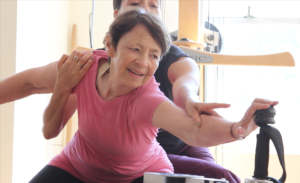
Many people don’t understand that spiral of the arm, so they might put down their thumb in a certain way and think, “Oh, I have pain.” But when they spiral the arm, the pain goes away. It connects into the thoracic spine and elevates the thoracic spine, which is needed for the end range of shoulder extension. Through the arms, the spiral is so important, and it’s incorporated in everything we do. We spiral inward, we spiral outward, and that mobility not only mobilizes the wrist, the elbow, the shoulder, but also goes into the clavicle and then into the thoracic spine.
That’s just an example of how wonderful the method is. The spiral lines are going through the whole system of the body, not just one joint. We’re not just doing external rotation of the arm, which is a PT thing, because if you don’t connect that into the thoracic spine with movement, then it’s not going to be functional.
You can’t throw a baseball with just one direction of movement. You have to spiral the arm and elevate the spine and rotate the spine…and then throw the ball. The spiral has to go through the whole body and even into the foot, which is what we do in the Gyrotonic Method. The opposition of the knee through the pelvis…that’s another important spiral line to save the knee, the ankle, and the foot, and get the power from the earth that can then send it through the spine.
The spiral is everywhere in our body and on every level. This system allows you to incorporate that into movement, which is needed for your body to work properly.
Cina: When you’re talking to other physical therapists who are skeptical about this system, how do you address that hesitancy?
Justine: A lot of talented physical therapists use manual therapy. They do joint mobilizations and fascial release. I tell them that one of the biggest perks of using the Gyrotonic Method is that we can strap people’s limbs in and then mobilize them in the straps. It takes a lot of wear and tear off our bodies as physical therapists. We can mobilize the hip, the knee, the ankle, while the weight of the machine is holding the weight of the leg. From a PT perspective, it’s easier on our own bodies, as practitioners, to work with the patients instead of just fighting to support them.
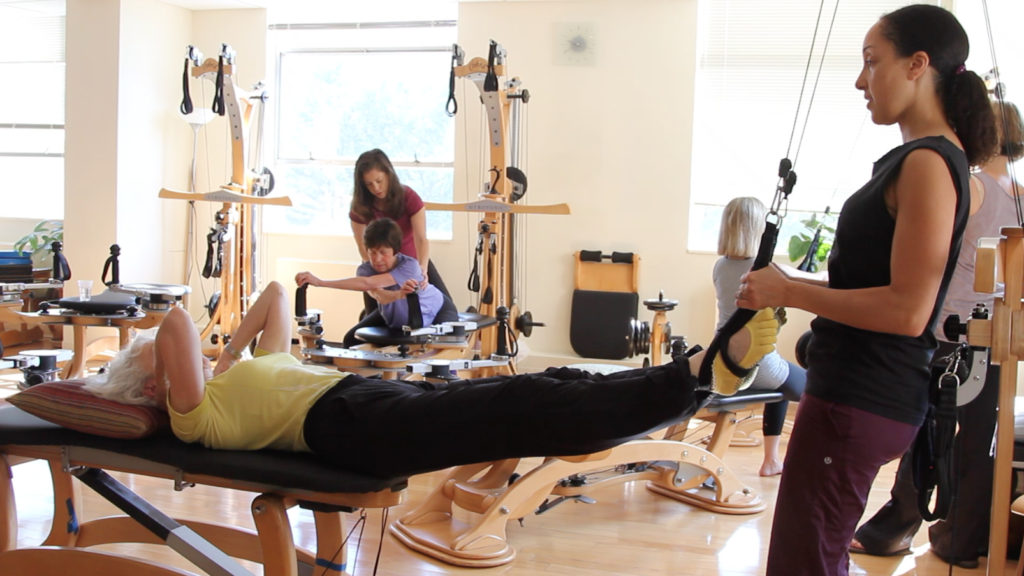
Cina: How do you see this system as being relevant in the future in the medical field?
Justine: I was just listening to research on fascia. Whatever direction you are coming at the body — whether it’s a musculoskeletal, neurological, or fascial direction — you can’t really separate them. The fascia squeezes and releases the nerves, and is also intertwined in an amazing network throughout the body.
The research that’s coming out on fascia development, like the importance of moving the fascia, moving the nervous system, creating space in the fascia and the nervous system and joints…the importance of these things is becoming more widely recognized. The research is proving what we already know instinctively, and through our own experiences. But to get the Gyrotonic Method into the medical world, we need this background and the research to prove that what we do is valid.
In my osteoporosis workshop, I talk about evidence-based medicine and how we can back up the Gyrotonic system with evidence from musculoskeletal research. It’s also going to be so exciting to base this system on fascial and nervous system research too. It’s so multifaceted. It works on every system, so it’s really exciting.
Cina: Tell me more about your osteoporosis workshop.
Justine: I teach the “GYROTONIC® Applications for Osteoporosis Course.” It came about because there was a conference in California on osteoporosis and scoliosis, and Matt Aversa from Gyrotonic Headquarters called and asked if I could present on osteoporosis. I was a few years out of physical therapy school at that point and was extremely fascinated by evidence-based research. I hit the library right away. I had stacks of research on the best way to strengthen the bones, what’s important when it comes to osteoporosis, etc. I just read all that I could. At that point, I had been teaching the Gyrotonic Method for about ten years.
I came up with this long research project, basically on the benefits, and ran it by my teachers. They pretty much said, “What’s your point?” I was like, “Uh…I don’t know what my point is.” So I kept developing it, and I think the course is now much better!
The course starts with two days of learning different exercises based on the Gyrotonic Method, which Juliu approved, and then goes into information on osteoporosis. On the final day, we work out the whole day. In each section, I talk about the benefit of the Gyrotonic Method.
The first class is based on a severely osteoporotic client and what a trainer would do with them. For example, working on fall prevention and posture is extremely important. One of the big contributors to the risk of falling is poor posture. With this method, we can work on gently mobilizing and strengthening the spine so that people are more upright. Also, we can help them learn how to weight shift in their upright spine, support their spine so they don’t fracture, and then strengthen the hips so they don’t fracture. We can do this in large ranges, not just in small ranges.
When our hips do fracture, that femoral neck, the weakest link, gets into a traction when we start to fall. When it’s in the hip socket, it’s always in a compressive state so we can stand up, so it’s a good thing. But when you fall, and if you fracture, the bone gets into a traction. With Gyrotonic exercises, we can train it in traction. With the traction series, we can move the leg in and out and in different directions so that femoral neck gets accustomed to moving and bending in different directions. Then if and when a fall happens, the bone is prepared for that and doesn’t fracture.
Not only can we strengthen the bones with weight bearing and using the cable system with increasing resistance, we can improve posture and get the bones mobile, supple, and ready for different movements — or ready for a surprise, or a trip, or whatever comes their way.
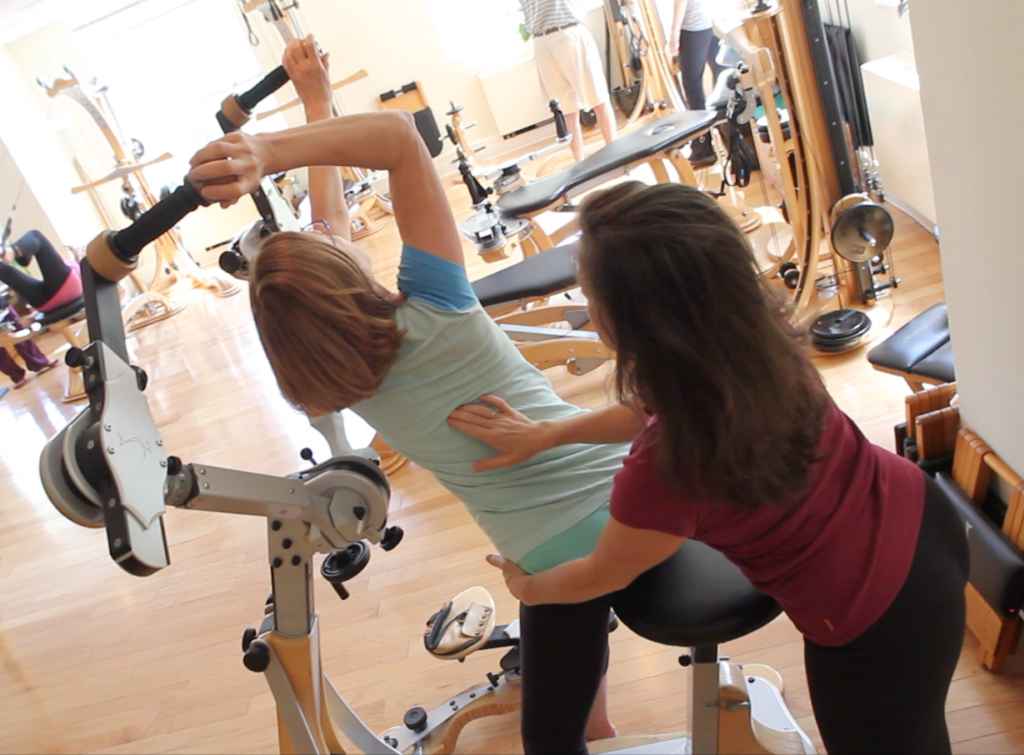
After we do a program on the severely osteoporotic client, we move to someone who just has osteoporosis. We look at bone scans and different places where osteoporosis can occur, and then continue to work on strengthening, weight shifting, fall prevention, etc.
The last program focuses on someone with osteopenia, which is a loss of bone, but not into the osteoporosis phase yet. In this country, we diagnose osteoporosis on bone density. It’s a two-dimensional image of the bone, which is then used to calculate how much bone density you have. It’s then compared to a young adult reference mean. Basically, you have a score, and based on that score, you either have some bone loss, or more bone loss, or bone loss with a previous fracture.
I think a lot of people come to this course because they have patients or clients who come in, not really understanding their diagnosis. It’s very confusing, and there is a lot of fear surrounding it. People often think they are just going to spontaneously fracture a bone. They’re told all of these rules like, “You can’t bend the spine, you can’t twist the spine, etc.” Those rules are not necessarily true. You have to find out what’s true, where it’s true, and who it’s true for.
The goal of my course is to educate Gyrotonic instructors on when it’s appropriate, and not appropriate, to work with clients with these issues, and how to do so in a safe manner. There are many ways to mobilize the spine in this method; you don’t have to just use the handle units. You can do it standing, sitting, or do homework at home with the Gyrokinesis Method which uses no equipment.
I only teach the course a few times a year because I have two kids and prefer not to travel a lot. I taught it here last year. It was so much fun because we had six physical therapists who also teach the Gyrotonic Method, so I could really talk about it from all levels. It’s exciting to see more physical therapists teaching the Gyrotonic Method and using it in their practices. Again, we’re so lucky in Washington D.C. to be able to use aides, which means people can be trained by me and then work under my license. Or they can be trained by another physical therapist and work under their license. It can be a blessing and a curse, but in this studio it’s a blessing. All of the teachers are trained so well through the Gyrotonic education process that they already know movement and know bodies. To then have the anatomy and science behind it, they just fly. It’s an amazing process to watch.
Cina: What would you say to someone who is considering the Gyrotonic education and becoming an instructor?
Justine: I want to mention the commitment it takes to become an instructor. I highly recommend it, but you’re not going to just be able to take a weekend course and then go teach. It’s about a year-long process, and it’s leveled out in a very intelligent way; you get a taste of it, you learn deeper, and then you actually teach it. It’s a whole different process than just doing it yourself. You experience it yourself, and then you learn how to teach it with a very thorough, laid out plan.
Of course, like with anything, that’s just the beginning. Even with PT school, that was just the beginning. Then I had to learn so much more. It’s the same with this work, and I’m still learning, even after more than 20 years of teaching.
Once you finish the Level 1 Foundation Training, you are qualified to teach a non-injured “normal” person, as an apprentice. There are then all of these wonderful continuing education courses you can take to learn how to teach people with specific issues.
But the foundation is wonderful, and it’s great to do for yourself. We have clients here who are eager to learn more and more, and they will take the pre-training just for their own self-learning. We’ve even had people buy towers for their own home use and continue to come in to get their own programs. It’s just a wonderful process.
Cina: Well, this has been a very helpful look into why this system is so much more than mere exercise. I look forward to learning more about the research that is coming out and to learn more from you in the coming years!
- Find dates and locations for Justine’s 3-day specialized course, “GYROTONIC® Applications for Osteoporosis.”
- Purchase Justine’s “Strategies for Teaching Clients with Osteoporosis: Bones, Balance and Gait,” an online video in the GYROTONIC® Master Class Series, exclusively for licensed Gyrotonic Trainers.
Leave a comment below with your thoughts!
————————–

Cina Canada is a GYROTONIC® Trainer and the Media Coordinator for GYROTONIC® International Headquarters.

Where are you? I need physical therapy that includes Gyrotonics for sciatica & balance issues.
Hello! There are licensed GYROTONIC® and GYROKINESIS® trainers and studios in over 80 countries around the world. You can find a studio/trainer near you via our Studio Finder at gyrotonic.com/studios. If there are no studios in your area, you can also look for virtual classes via our Virtual Class Finder gyrotonic.com/find-a-virtual-class/. Best wishes on your new spiraling journey and let us know if we can help further!
Cina – looking for medical research studies in Gyrotonics. Any sites you can steer me to?
Hi, Eric. There are no published medical research studies that we are aware of. There are, however, a variety of small academic papers that can be found via a Google search. I hope this helps!